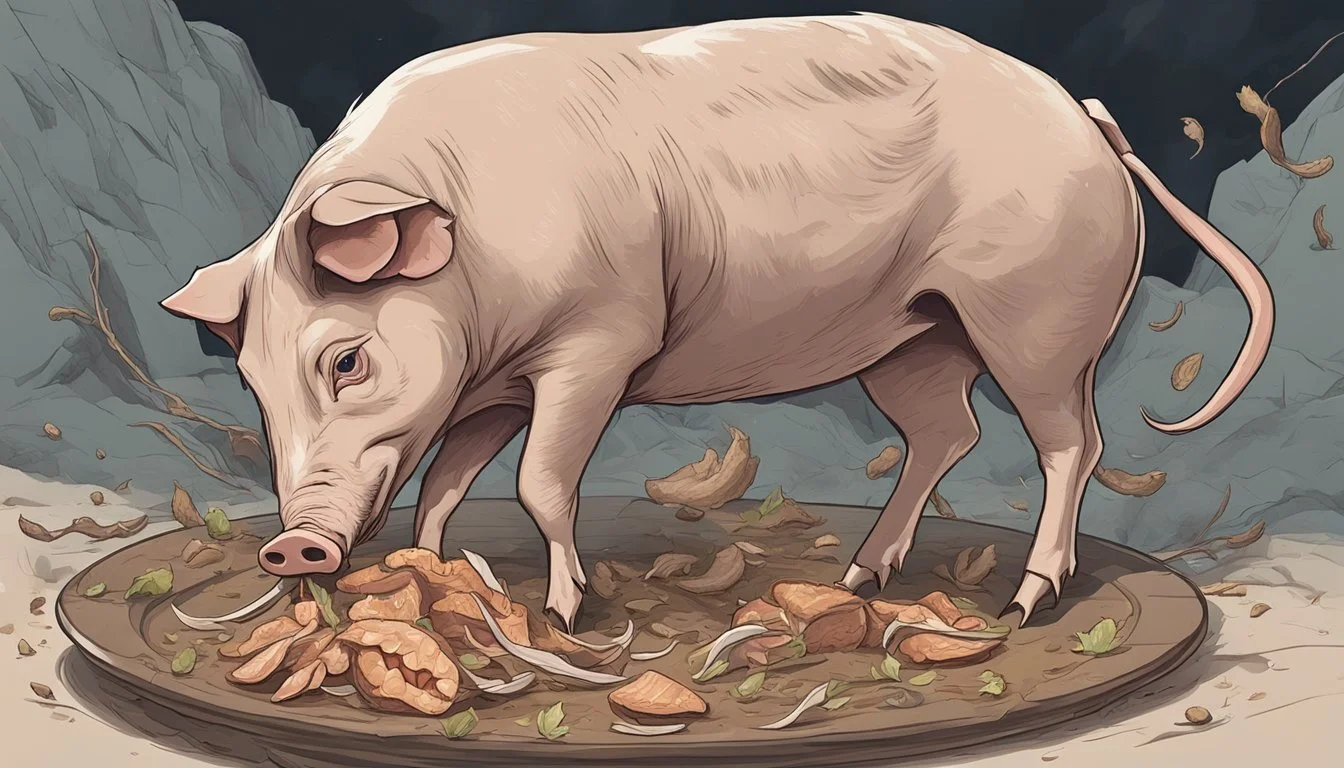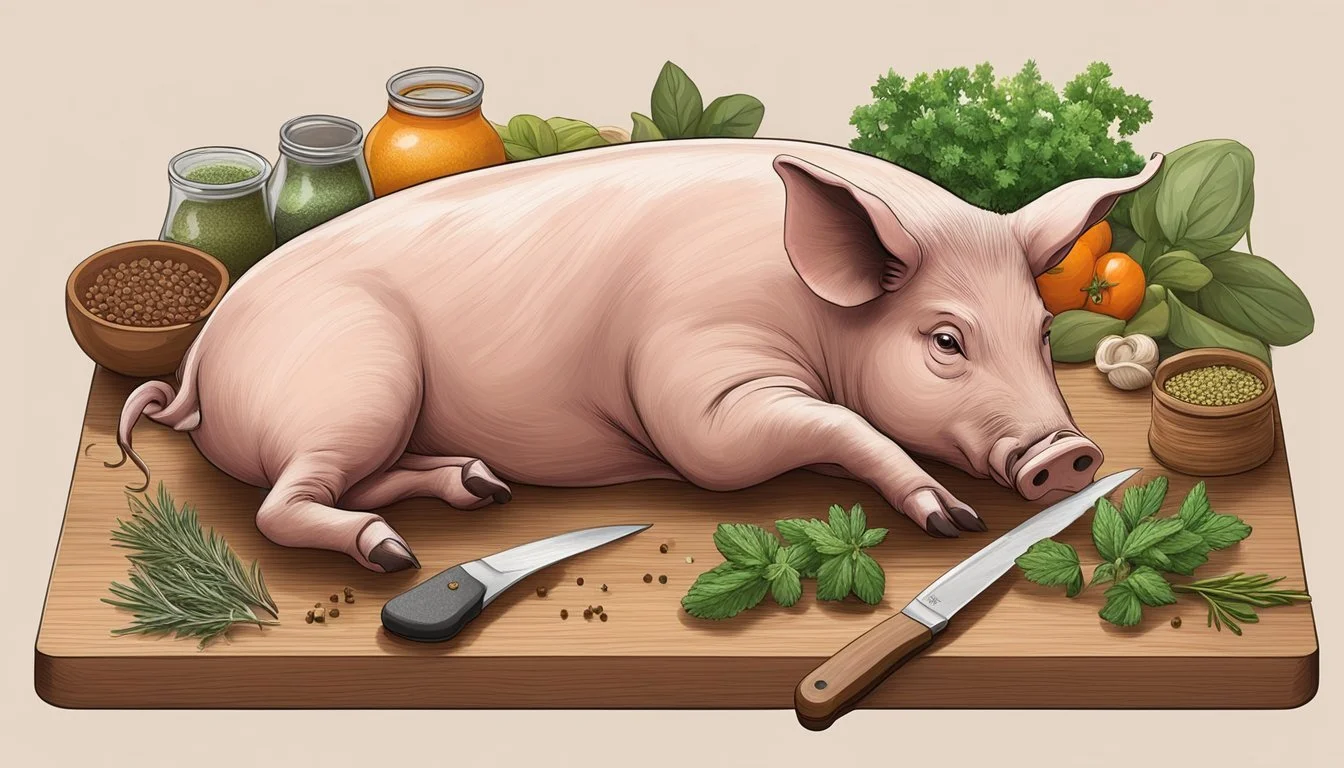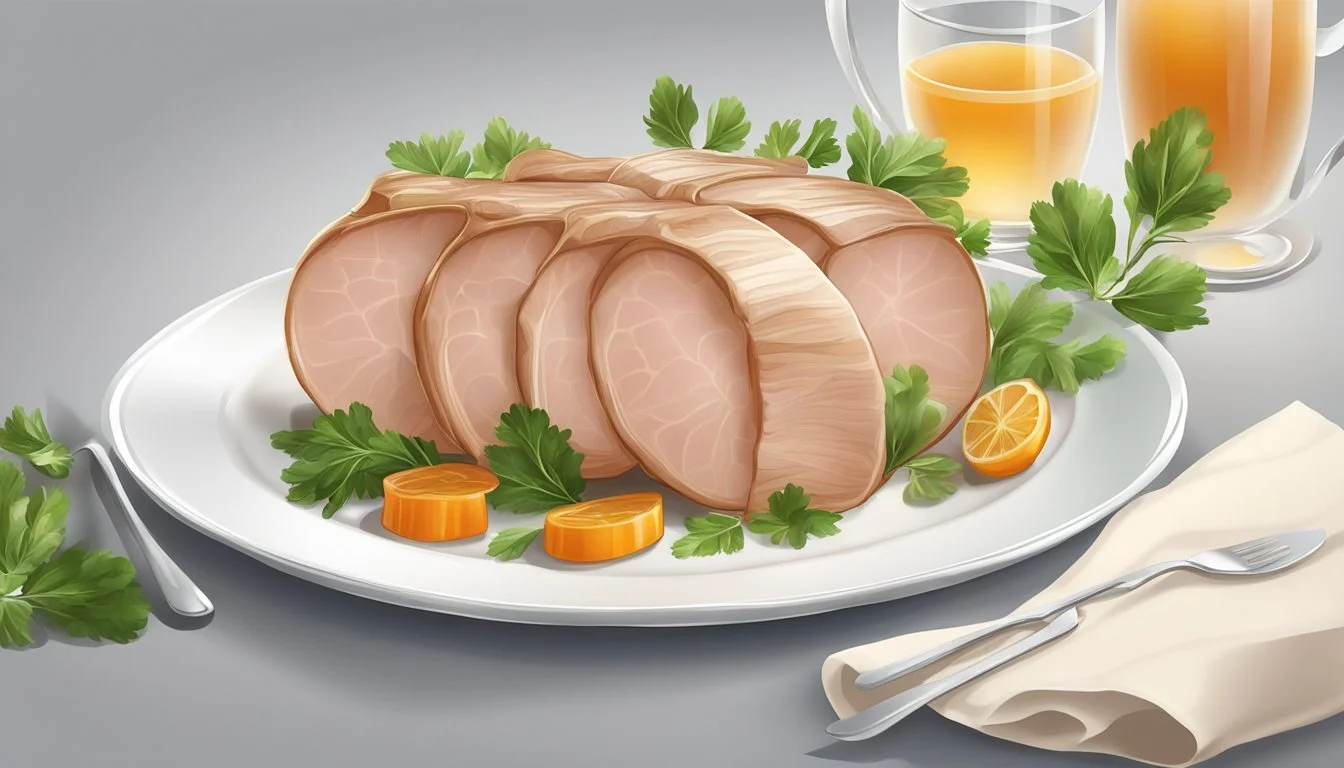How do you eat a pig's trotter?
Unveiling the Culinary Techniques
Pig's trotters, the culinary name for the feet of a pig, are a unique and traditional ingredient in many cultures around the world. To eat pig's trotters, they are typically cooked through slow methods such as braising or stewing, which allows the tough collagen in the skin and joints to break down into a rich, gelatinous texture. This not only tenderizes the meat, but also releases key nutrients, making it a flavorful and wholesome dish.
The slow cooking process involved in preparing pig's trotters ensures the meat becomes succulent and the connective tissues soften to enrich the dish with a creamy, unctuous quality. Known for their high protein and iron content, trotters can be a valuable addition to a balanced diet, contributing to muscle strength and overall health. However, the absence of fiber means they should be consumed with a variety of other foods to maintain dietary balance.
Selecting Quality Pig's Trotters
When choosing pig's trotters, the consumer's focus should aim at identifying signs of freshness and understanding the various cuts offered by butchers. These factors are pivotal to ensuring a satisfying culinary experience.
Identifying Freshness
To ascertain the freshness of pig's trotters, one should look for firm, plump feet with a healthy coloration, typically ranging from pale pink to slightly reddish. The skin should be smooth and free of any blemishes or discolorations. Any unpleasant odor is a clear indication that the trotters are not fresh and should be avoided.
Understanding Different Cuts
Pig's trotters can be categorized into two main cuts:
Whole Trotters: This cut includes the entire foot and is often used in recipes that call for slow-cooking methods to tenderize the meat thoroughly.
Pettitoes: These are the smaller cuts, or the tips of the trotters, which are sometimes preferred for quicker cooking dishes.
When purchasing pig's trotters, it's beneficial to inquire with the butcher about the source of the trotters and the best-suited cut for the intended cooking method. The distinction between whole trotters and pettitoes can significantly affect cooking times and final dish presentation.
Preparation Essentials
When preparing a pig's trotter for cooking, it's crucial to start with the basics: proper cleaning and hair removal, and tenderizing the meat. This lays the foundation for a delicious meal, as these steps ensure the trotter is ready to absorb flavors and achieve the desired succulence.
Cleaning and Hair Removal
A pig's trotter comes with the skin on, and it must be thoroughly cleaned to remove any residual dirt or debris. One typically begins by rinsing the trotter under cold water. In the cleaning process, any remaining hairs should be carefully burned off using a culinary torch or scalded with boiling water and scraped away. Participants often immerse the trotter in a mixture of salted water to additionally cleanse it—not only does this step further clean the trotter, but it can also help in the removal of any lingering hairs.
Tenderizing the Trotter
Tenderizing the trotter is essential since the meat and connective tissues are inherently tough. The goal is to soften the trotter to make it palatable and favorable for slow cooking methods. This is generally achieved by simmering it in boiling water. The water should be seasoned with salt and other desired spices to start imparting flavors into the meat during the tenderizing phase. The trotter should simmer until the meat becomes tender, checking periodically. Depending on the size of the trotter and the desired level of tenderness, this process can take several hours.
Cooking Techniques
To achieve the best flavor and texture, pig's trotter can be prepared using various cooking methods suited for its unique composition.
Boiling Basics
Boiling is often the first step in cooking pig's trotters. It begins with simmering the trotters in a pot of salted water for about an hour. This softens the tough connective tissues. A thorough pat-drying follows before additional cooking or seasoning.
Braising Methods
Braising pig's trotters involves cooking them slowly in a flavorful liquid. This method allows the meat to become extremely tender. Typically, the trotters are seared first and then simmered in a combination of stock, herbs, and spices on the stove-top or in an oven, often as part of a stewed dish.
Slow Cooking Advantages
Using a slow cooker or crockpot for pig's trotters can yield tender results with minimal effort. The slow, steady heat helps break down the trotter's dense connective tissue over several hours, enhancing flavors and preserving moisture. Alternatively, a pressure cooker can expedite this process significantly while retaining the desired tenderness.
Alternative Cooking Methods
Aside from traditional methods, pig's trotters can also be cooked using alternative techniques. After initial boiling, one could finish cooking under a broiler or in an oven to create a crispy crust. Another method—sous vide—allows the trotters to be cooked evenly at a controlled temperature, ensuring a consistent texture throughout.
Flavoring and Seasoning
The key to a delectable pig’s trotter dish lies in the judicious use of seasonings and marinades. Select spices and sauces infuse the trotters with rich flavors and aromas, tenderizing the meat and enhancing its natural taste.
Spice Selection
When selecting spices for flavoring pig’s trotters, it's important to consider a combination that imparts depth and complexity. Salt and pepper are essential for basic seasoning, providing the foundational taste profile. To inject warmth and a piquant edge, garlic, ginger, and onions are indispensable. Their aromatic qualities complement the meat’s richness.
It's common to integrate sweetness to balance the robust flavors, often achieved with sugar or brown sugar. For an aromatic sweetness with added complexity, star anise plays a crucial role. Meanwhile, light soy sauce and dark soy sauce contribute saltiness and a distinct umami character, while beer and cooking wine, like mirin, introduce nuanced flavors and assist in tenderizing the meat.
The spice profile may include, but is not limited to:
Salt: 1-2 teaspoons (adjust to taste)
Pepper: 1/2 teaspoon
Garlic: 3-4 cloves minced
Ginger: 1 tablespoon, grated
Brown sugar: 1 tablespoon
Star anise: 1-2 pods
Dark soy sauce: 2 tablespoons
Sauces and Marinades
The art of marinating pig’s trotters not only flavors them but also tenderizes. Soy sauce, being rich in umami, serves as the base for many marinades, while doenjang (a Korean soybean paste) or samjang (a combination of red pepper paste and soybean paste) introduce a deep savory element often found in Korean cuisine. Rice syrup or sugar may be added to the marinade for a hint of sweetness that counters the savoriness.
For a base marinade, one might consider:
Light soy sauce: 1/4 cup
Stock: 1 cup
Rice syrup or sugar: 2 tablespoons
To this foundation, additional flavorings like minced garlic and ginger, or cooking wine, can be included for extra dimensions of taste. The pig’s trotters should be braised in this mixture, ensuring the flavors penetrate the meat over the cooking period.
Traditional and Modern Recipes
The section explores the diverse culinary approaches to preparing pig's trotters, ranging from time-honored recipes that implement slow-cooking techniques to more contemporary variations introducing new flavors and presentations.
Classic Pig's Trotter Dishes
Traditional pig's trotter recipes often involve the use of rich stocks and a variety of hearty vegetables to complement the flavors. A quintessential French dish featuring this ingredient is the Pieds de Cochon, renowned for being a Christmas specialty. The preparation begins by slow-cooking the pork feet in a savory stock with aromatic herbs such as thyme and a mélange of vegetables including onions, carrots, and celery. Some versions may include beans or potatoes, which absorb the essence of the gelatinous meat, creating a deep, robust flavor profile.
In Spain, traditional pig's trotter dishes incorporate ingredients such as chorizo and butter beans, melding the rich gelatinous texture of the trotters with the spices of the sausage. The trotters are typically cooked until the meat is tender enough to easily separate from the bones.
Asian cuisines also have their take on pig's trotters, with Korea offering Jokbal — a dish where the trotters are braised in a blend of soy sauce, ginger, garlic, and rice wine, then sliced and served with sides of fermented shrimp sauce and kimchi.
Innovative Trotter Preparations
Modern recipes are redefining the ways to enjoy pig's trotters, incorporating both new cooking methods and unexpected ingredient pairings. Chefs are experimenting with techniques like sous vide to achieve precise tenderness, and pairing trotters with unconventional flavors and textures.
An example of an innovative trotter dish might be a trotter terrine, where the cooked meat is finely chopped, mixed with spices, and pressed into a mold to set. Once firm, it is sliced thin and served alongside a sharp, tangy relish or a sweet fruit compote to balance the richness.
Another modern approach is to utilize crispy breadcrumbs and browned butter to create a texturally contrasting coating for roasted trotter preparations. This method not only adds an appealing crunch but also enhances the flavor complexity through the process of browning, giving a nod to classic culinary techniques while still venturing into new gastronomic territory.
Serving and Presentation
When serving pig's trotters, it is crucial to consider both the accompaniments that complement the dish and the plating techniques to enhance its presentation. A well-presented braised pig trotter can turn it into a delicious and visually appealing centerpiece.
Accompaniments
Braised pig trotters pair wonderfully with a variety of side dishes that can balance their rich and savory flavor. The following are common and recommended accompaniments:
Mashed Potatoes: A creamy and smooth texture of mashed potatoes complements the succulent gelatinous texture of the trotters.
Green Vegetables: Steamed or sautéed green vegetables like spinach, green beans, or kale offer a fresh and slightly bitter contrast to the dish's richness.
Sauce: A well-reduced sauce, sometimes made from the braising liquid, is drizzled over the trotters to enhance their flavor.
Plating Techniques
Presentation of pig's trotters should be done with attention to detail to elevate the dining experience. Techniques include:
Highlighting the Trotter: Place the trotter centrally on the plate to make it the focal point.
Sauce Artistry: Utilize a spoon or sauce bottle to artfully drizzle sauce around the plate or atop the meat.
Contrasting Colors: Arrange the accompaniments strategically to create a visually striking palette, with the golden-brown hue of roasted trotter or the dark sheen of a stewed trotter against the vibrant green of the vegetables.
Nutritional Profile and Health Benefits
Pig trotters are known for their unique nutrient composition, providing considerable health benefits when consumed responsibly. A significant attribute of pig's feet is their protein content. Protein is essential for muscle strength and repair, and pig trotters are a rich source of this macronutrient.
In addition to protein, pig trotters contain iron, a mineral critical for blood health. Iron assists in the production of hemoglobin, which transports oxygen throughout the body. Regular consumption of foods high in iron, like pig trotters, can support the maintenance of adequate iron levels, potentially preventing iron-deficiency anemia.
Another notable component is collagen, which the body converts into gelatin during cooking. These substances not only contribute to the gelatinous texture that makes trotters a sought-after ingredient for soups and stews but also offer health benefits. They may support joint health, improve skin elasticity, and aid in digestive function.
Pig trotters are also a source of calcium, albeit in smaller amounts compared to dairy products. Calcium plays a vital role in maintaining bone health and strength, and it's an important mineral for the body's various physiological processes.
Nutrient Benefit Protein Supports muscle repair and growth Iron Essential for healthy blood and oxygen transport Collagen May improve skin health and joint function Calcium Contributes to bone health
Although pig trotters provide these health benefits, it is important to consider their high fat content and include them as part of a balanced diet. Consuming trotters in moderation can enhance one's nutrient intake without compromising overall dietary goals.
Pig's Trotters in Culinary Culture
Pig's trotters, also known as pig's feet, have a storied place in gastronomy worldwide, from traditional uses in holiday feasts to their resurgence in modern restaurants.
Historical Significance
Historically, pig's trotters have been a valuable food source due to their rich collagen content. They have played a part in the cuisines of various cultures, notably in France and Spain, where every part of the pig is utilized in cooking, reflecting the countries’ no-waste approach to food. They are often slow-cooked to achieve a tender, gelatinous texture and have been an enduring element in rustic, peasant cuisine.
Cultural Celebrations
Pig's trotters feature prominently in cultural celebrations across the globe. For instance, during Chinese New Year, pig's trotters are prepared in a stew as a symbol of wealth and abundance. Other countries, such as Korea, incorporate trotters in festive dishes and serve them at restaurants, particularly in braised form. Spain and France, too, showcase pig's feet during particular festivals and Christmas time, marking their unwavering presence on celebratory tables.
Culinary Revival
The late 2000s saw a revival of pig's trotters in the culinary scene, with restaurants reintroducing them in innovative ways. This renewed interest stems from a combination of factors including the nose-to-tail dining trend and an appreciation for their flavor and textural qualities. This resurgence has rekindled interest in traditional recipes while inspiring contemporary renditions, cementing pig's feet once again as a cherished ingredient in global cuisine.
Purchasing and Storage Tips
When selecting pig's trotters, also known as pig's feet, consumers should focus on freshness and quality. The source of the trotter, whether from a pig or boar, can affect the fat content and taste, emphasizing the importance of reputable butchers and stores.
Where to Buy Pig's Trotters
Pig's trotters can be purchased from a variety of sources, each offering different levels of quality and freshness:
Local Butchers: Typically offer the freshest options and can provide specific cuts on request.
Supermarkets: May carry pre-packaged trotters, both fresh and frozen.
Ethnic Markets: Often stock a wider range of pig's feet, catering to traditional recipes.
It is advisable to choose trotters with a balanced amount of fat, ensuring better flavor and texture when cooked.
Storing for Freshness
Pig's trotters should be stored correctly to maintain their quality until ready to be cooked:
Refrigeration: Keeps trotters fresh for up to 3 days when stored in the coldest part of the refrigerator.
Freezing:
Wrap trotters securely in cling film or a freezer bag to prevent freezer burn.
Store in the freezer for up to 6 months for optimal taste and quality.
Transfer frozen trotters to the refrigerator a day before cooking to allow for safe thawing.
Safety and Precautions
When preparing pig's trotters, individuals should ensure that safety and hygiene are paramount. The trotters must be thoroughly cleaned before cooking, as dirt or debris can often be tucked away in the crevices of the feet. Cleaning typically involves scraping away any excess matter and rinsing the trotters under cold running water.
Salting plays a critical role in both the cleaning process and the initial cooking stage. It can help to draw out impurities. One might consider soaking the trotters in salted water as an added precaution to help cleanse them.
Boiling the trotters is not only a method for tenderizing but also for ensuring safety. They should be placed in a pot of boiling water, which can further help to remove impurities. The heat must be sufficient to ensure that the meat is cooked thoroughly, eliminating the risk of foodborne illnesses.
Proper handling and storage of the pig's trotters, before and after cooking, are also important safety measures. Users should always keep the raw and cooked trotters separate to avoid cross-contamination, and refrigerate any leftovers in a timely manner to prevent the growth of bacteria.
In summary, maintain a clean environment, use heat effectively to prepare the trotters safely, and always handle the meat with care to avoid contamination.
Skin and Health Care Uses
Pig's trotter, primarily composed of skin and connective tissues, provides a rich source of collagen and gelatin, which have various implications for skin health and care remedies.
Benefits of Collagen and Gelatin
Collagen and gelatin, derived from the connective tissues of pig's trotters, are proteins that play essential roles in maintaining the elasticity and strength of human skin. Collagen is crucial for combating the formation of wrinkles and slowing the signs of aging. It promotes healthy skin by enhancing its elasticity and hydration. Gelatin, a cooked form of collagen, similarly benefits the skin by potentially boosting its moisture retention and texture.
Nutrient Skin Benefit Collagen Reduces wrinkles, promotes elasticity Gelatin Enhances moisture, improves texture
Both these proteins may be used in homemade skincare treatments, as well as in dietary supplements, to support overall skin health from within.
Homemade Remedies
Individuals often use pig's trotter in homemade broths and stocks to harness its potential skincare benefits. As the trotter simmers for an extended period, the collagen and gelatin dissolve into the liquid, creating a base that can be consumed directly or incorporated into various dishes.
Recipes may include:
Broths: Slow-cooked with herbs and vegetables
Jellies: After cooling, the liquid sets into a jelly due to high gelatin content
These homemade solutions have been traditionally esteemed for their purported skin care properties, believed by some to aid in maintaining a healthy and youthful skin appearance.
Frequently Asked Questions
How do you clean a pig's trotter before cooking? One must meticulously clean pig's trotters prior to cooking to ensure they are free of impurities. This entails scrubbing the skin and soaking them in water. It's often recommended to rinse them under cold running water and remove any residual hairs, which can be singed off. Afterward, pat them dry before proceeding with your preferred recipe.
What is the best way to cook pig's trotters so that they become tender? To achieve tender pig's trotters, slow cooking methods are ideal. The procedures usually include:
Braising in a flavorful liquid, allowing the meat to tenderize over several hours.
Simmering in a seasoned broth, followed by roasting or glazing to enhance the flavor.
A pro tip for tenderness is to maintain a low and slow cooking approach.
Should I add salt when cooking pig's trotters? Including salt in the cooking process is essential. One might initially simmer the trotters in salted water and then season accordingly within the chosen recipe. The salt aids in both seasoning the meat and in the tenderization process.
Could you suggest a simple pig's trotter recipe? A basic recipe would involve:
Cleaning and simmering the trotters in salted water.
Removing, drying, and then scoring the meat for better seasoning absorption.
Braising or roasting with a mix of herbs, spices, and possibly a glaze of honey or brown sugar.
Throughout the cooking process, it's important to regularly check for flavor absorption and tenderness.








